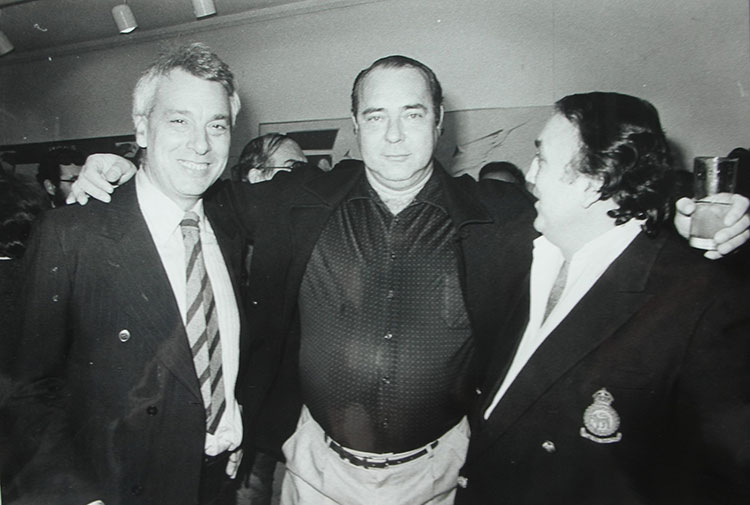
Dragoš Kalajić i Aleksandar Lončar
Laslo Sekelj
Jews make up a tiny segment of the former Yugoslavia’s ethnic mosaic. According to the estimates, there are between 5,000 and 7,000 Jews in (former) Yugoslavia. These are the figures following three waves of communal emigration to Israel in the period 1948-51 (around 8,000 left, including individual migrants). Local communities, members of the Union of the Jewish Communities of Yugoslavia (until 1991), have altogether less than 5,000 members of which 15 per cent are closely related to Jews (mixed marriages) but were not born as Jews.[1]
From the time the Communists came to power until the final disintegration of the Yugoslav state (1945-89), three different stages of antisemitism can be distinguished: (1) 1945-67, a period characterized by its lack of any public display of antisemitism; (2) 1967-88, a period of antisemitism disguised as anti-Zionism; (3) 1988 to date, a period of ‘republicanization’ and the manipulation of Jews.
1945-67 the Yugoslav idyll
During the two first decades of its existence, the renewed Yugoslav state went through an idyllic phase of ‘brotherhood and unity’. Nationalism and subsequently antisemitism were latent phenomena, but under authoritarian Communist rule all such tensions had to be eradicated. Yugoslavia’s version of socialism was characterized by an official rejection of every form of ethnic intolerance. True, there were many cases when antisemitic prejudice and feeling were expressed on an individual basis and all were tried in court in keeping with the Law on the Prohibition of Incitement of Ethnic, Racial and Religious Hatred and Dissension. In all the cases, antisemitic feelings were expressed verbally and were based on personal intolerance. While researching the archives of Belgrade’s Jewish Historical Museum, I came across twelve such cases recorded in the territory of Vojvodina and Slavonija.[2]
Within the framework of a UNESCO project, a special committee examined Yugoslav history textbooks for schools in 1954; it made no negative comments at all.[3] Combing archives and other sources in search of antisemitism in the public domain, I came across the following cases: a theatrical performance of a troupe in Sombor (1946); the Czech film Nikolay Shuhay; and a newspaper article published in Ljubljanski dnevnik on 24 September 1951.[4] All the cases I came across were relatively insignificant given the facts that the Union of Jewish Communities of Yugoslavia was free to operate in this period, that the state enabled three large groups of Jews to emigrate to Israel, that it allowed individual emigration later on, and that the Union, unlike Jewish organizations in other Communist countries, took part freely in all activities of international Jewish organizations, except the World Zionist Congress.
1967-88: ‘Non-aligned’ anti-Zionism
Together with the member states of the Warsaw Pact, Yugoslavia broke off diplomatic relations with Israel in 1967. Moreover, it became the leading advocate of anti-Zionism in the non-aligned movement and was practically the loudest critic of Israel outside the Arab-Muslim world. Antisemitism appeared on the political scene under the guise of anti-Zionism, but it was of limited importance. Despite the fact that anti-Israelism practically gained the status of a state ideology at the time when this policy was at its peak, efforts were regularly made to issue warnings about antisemitism.
Unlike the countries of the Warsaw Pact, the Jewish community in Yugoslavia was not required to follow state policy. Local Jewish communities and the Union maintained relations with Israel and Jewish organizations. Occasionally, however, there were problems with local authorities regarding group visits to Israel. In addition, some individuals did come across problems due to their pro-Israel or ‘pro-Zionist’ stands. On the other hand, antisemitic articles in the press under the guise of criticism of Israel and ‘anti-Zionsim’ did not reflect the official viewpoint—as it was verbally stressed by political representatives. In this period, however, no criminal charges against persons or institutions in relation to antisemitism were ever brought to the courts.
There were three types of antisemitic activities in this period: first, Muslim-Arab propaganda; second, Freemason-Jewish conspiracy charges inspired by The Protocols of the Elders of Zion; and third, traditional Christian anti-Judaism.
a. Muslim-Arab antisemitic propaganda.
During this period, The Protocols of the Elders of Zion was the focal point of interest in all public manifestations of antisemitism in Yugoslavia. Muslim-Arab propaganda relating to the Six-Day War and the Palestinian question paved the way for the reprinting and dissemination of this bible of antisemitism. The Muslim antisemite, Hadži Husein Đozo, wrote, in the Muslim magazine Hrvat (The Croat), published in 1943 in the Ustasha state: ‘Throughout history, Jews were the greatest threat to the human race.[5][6] A quarter of a century later, this ‘expert on the Jewish question’ spoke in the name of Yugoslav Muslims at the world conference of Ulemas in Cairo, proclaiming the Jihad—’holy war against members of the Jewish tribe wherever they may be’. As editor-in-chief of the Muslim magazine, Preporod (Renasence), he made his contribution to the Jihad by publishing Lutvo Kurić’s article ‘Jewish Justice’. This text was identical to Đozo’s earlier writings of 1943: ‘It is difficult to list all the atrocities of the Jewish people … All the reactionaries and the powers of evil in the world have arisen to assist and defend the Jews.[7]
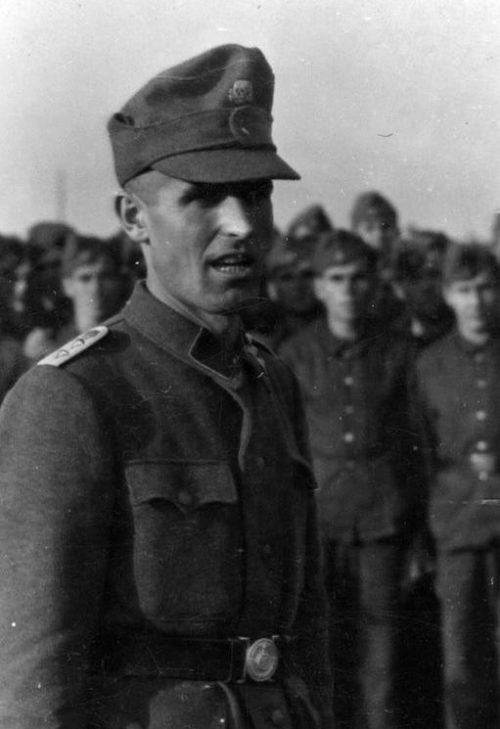
Husein Đozo
After the Arab-Israeli war in 1967, thousands of Palestinian students came to study in Yugoslavia. Their associations published various propaganda pamphlets, including a translation of the Arab version of The Protocols. One particular pamphlet, published in Zagreb, found its way into Novi Sad student’s magazine, Index, under the title ‘Just Struggle of the Palestinian People’.[8] At the same time, in the Yugoslav version of Reader’s Digest, the review Izbor, an article from the arsenal of Soviet antisemitism was published: S. Milin’s ‘They Were Brought Up on Zionism’.[9] Apart from these clearly antisemitic articles published within the framework of the anti-Israel campaign and following instructions received by journalists, a series of anti-Israeli texts—spiced with elements of antisemitism either on purpose or out of ignorance—were carried by the most influential daily and weekly newspapers, as well as radio and television.[10]
Anti-Israelism controlled from above and disseminated by the press had all the characteristic features of Communist authoritarianism but, unlike in Eastern Europe, efforts were made from the same side to avoid triggering anti-Jewish feelings. The fact that there were relatively few antisemitic texts and that there was nothing which would indicate coordinated action in their production indicated the main difference with anti-Israeli campaigns elsewhere in Eastern Europe. It is also important to stress that many of them, unlike in other countries, provoked critical public reaction.[11] The entire Yugoslav press, including the official gazette of the Communist Party, Komunist, and professional associations, unanimously condemned the antisemitic campaign in Poland in 1968. Nevertheless, none of the criminal charges brought by the Jewish Union against those inciting ethnic hatred yielded results, not even those brought against one of the products of the widely condemned Polish antisemitic campaign: Janus Pialkevitch’s book, The Long Hand of Israel (Zagreb: Alfa, 1978), i.e. against the author of the preface (‘All Jews Are Agents of Mossad’), R. Vukadinović. On the other hand, no one reacted when—during the authorities’ organized anti-Israeli rally after the massacre in Palestinian camps in Beirut—an effigy bearing the sign ‘Jude’ was burned and displayed with the slogan ‘Sons of Judas, we shall revenge Beirut.[12] It is worth noting that a group of Belgrade intellectuals, who at the same rally expressed their support for Poland’s Solidarnosc, was arrested immediately and sentenced to imprisonment through a summary procedure.
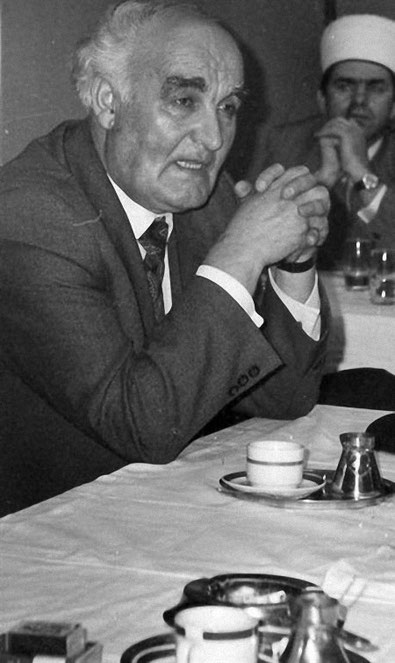
Husein Đozo
b. Revival of The Protocols of the Elders of Zion.
In early 1971, for the first time after almost forty years, the bible of antisemitism, The Protocols of the Elders of Zion, appeared on the Yugoslav public scene. Aleksandar Lončar’s article, ‘Regarding New Attempts to Publish the Complete Works of Lui Fernando Delush-Celine’, published by Titograd’s literary magazine, Ovdje, claimed ‘the power of Jews’ to be the main reason for the ‘unfortunate’ fate of two great antisemitic authors: Celine and Ezra Pound. The author spoke of the ‘high documentary value of the facts presented in The Protocols of the Elders of Zion’. The writer Danilo Kiš reacted very critically to this article.[13] Lončar was not the only one to promote The Protocols: he was followed by Dragoš Kalajić[14] in Belgrade’s literary magazine, Delo, proclaiming them the authentic documentary source for evaluating the Jewish religion.[15] (Even today, Kalajić writes on the ‘Jewish-Freemason conspiracy’ in various reviews and magazine articles.) The author and painter, Miro Glavurtić[16] also belongs to this circle. In 1978 he used private funds to publish his book, Satan, in which he paraphrased The Protocols; it was criticized in the principal Serbian daily, Politika, by M. Stanisavac (8 February 1979). The Jewish Union pressed criminal charges but in vain. The same happened four years later when Glavurtić launched another private publication, Hounds, in which he wrote about the Jews in the same manner. This time it was attacked by I. Mandić in NIN (8 August 1982), while the Union pressed charges once again with no result. At the same time, the journalist N. Višnjić claimed in a television news broadcast that The Protocols were the work of a council of five rabbis seated in New York. Later, the television station (Beograd) apologized for this incident. Finally, in December 1983 and January 1984, Belgrade’s Ilustrovana Politika published, over a period of six weeks, feuilleton about Freemasons. The text incorporated parts of The Protocols which were, naturally, claimed to be the ‘truth about Jews’. After much haggling, arguing and political intervention, the further publication of M. Popovski’s feuilleton ‘The Mysterious World of Masons’, was halted by the editorial board of Ilustrovana Politika. But, in 1984, a book published by Nova knjiga under the same tide appeared in Belgrade. It was banned after one year but appeared eventually in Macedonia—and was prohibited again. In the late 1980s, the original version appeared again in Belgrade bookshop windows, and was banned for the third time.
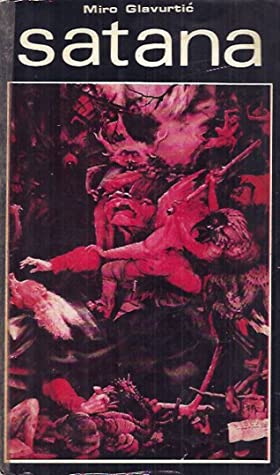
c. Traditional anti-Judaism, stereotypes and prejudices.
The Serbian Orthodox Church has not stopped accusing the Jews of deicide to this very day. In the 1970s and early 1980s, the magazine Pravoslavni misionar published a series of articles of this type.[17] In newspapers at that time, the usual stereotypes and prejudices about Jews could occasionally be found, but they were published without deeper political connotations.[18]
The ‘republicanization’ of antisernitism and the manipulation of Jews
The final disintegration of Yugoslavia started in the second half of the 1980s. Political activity was reduced to the pursuit of aggressive and chauvinist national interests, while federal units, i.e. the republics, began acting as individual states. As a sovereign state and united political community, Yugoslavia ceased to exist well before its formal disintegration in June 1991. At the height of nationalist skirmishing, even Jews were manipulated politically for the benefit of the different Yugoslav nationalist elites. As Yugoslavia experienced bloody disintegration, antisemitism appeared once again. But an entirely new phenomenon appeared: the (mis)use of Jews for the nationalist purposes of the communities of the former Yugoslavia.
Slovenia.
The first manifestation of the misuse of Jews for nationalist agendas emerged in Slovenia. The rally held in Cankarjev Dom (February 1989), which served to strengthen Slovene national identity, took place under the Star of David. This Jewish national symbol served to promote the nationalist coalition and was misused in an anti-Yugoslav and anti-Serbian campaign which claimed that the ethnic Albanians in Kosovo, together with Slovenes, were suffering the fate of the Jews in Yugoslavia. The Jewish Union, unsuccessfully, pressed charges against the organizers for the abuse of the Star of David and lodged a public protest as well. The criminal charges were dismissed. The formal organizer of the gathering was a youth organization which later on evolved into the Liberal Democratic Party. Commenting on the Union’s protest, a magazine close to the youth organization asked: ‘Why have the Jews pressed criminal charges? Because they want money, of course.[19] Eventually, another youth magazine announced that in Slovenia the closed season on antisemitism was over. After all, antisemitism used to be a component part of Slovenian nationalism. Ljubljana University’s magazine, Tribuna, published The Protocols of the Elders of Zion from August 1988 to March 1989, and it was impossible to secure the suspension of its publication. This was the first straightforward publication of The Protocols in Yugoslavia since 1945. Nobody protested and it in no way tarnished the democratic image of the leading secessionist republic of the former Yugoslavia.
Croatia.
Before the Second World War and during the existence of the Fascist Independent State of Croatia, this former Yugoslav republic was clearly the most antisemitic region in Yugoslavia. However, since 1945 and up until the election campaign in 1990, Croatia had been, in this respect, a quiet region. It is no coincidence that the re-emergence of Croatian separatist nationalism occurred alongside the beginning of inter-ethnic tensions with Serbs and the emergence of antisemitism. Antisemitism and anti-Serbism are (and used to be) constituent elements of Croatian anti-Yugoslavism and secessionism.
On the eve of the election campaign, Matica Hrvatska published Franjo Tudjman’s book, The Wasteland of Historical Reality. In this book, the future father of Croatian statehood portrayed Jews in the Jasenovac concentration camp as assistants of the Ustasha, who were in charge of ‘selecting prisoners for execution and [who] sometimes even carried out those executions themselves’. In another chapter, he wrote that ‘there is a small historic step from Nazi-Fascism to Judeo-Nazism[20], having in mind the Israeli-Palestinian conflict. During the election campaign, the three leading figures of the winning Croatian Democratic Party—Franjo Tudjman (‘My wife is, fortunately, neither Serbian nor Jewish’), Vladimir Šeks (‘Evil Jews’) and Šime Djodan (‘Serbs and Jews are conducting a campaign against Croatia abroad’)—made antisemitic statements and even then the main object of their attacks was the Serbs.” The interview given by Ivo Omračin during the election campaign was also explicitly antisemitic. (During the war-time Ustasha state, Omračin was charge d’affaires in Berlin.) Among other things, he accused Jews of crimes committed by the Ustasha. He denied the very existence of Jasenovac, the only death camp that was not run by Germans, and claimed that the mass executions in this concentration camp (hundreds of thousands of Serbs, Gypsies and Jews) were perpetrated by Jews. In this interview they were also accused of spreading Bolshevik propaganda and poisoning everything around them.[21] Criminal charges were pressed against Omračin by the Jewish community in Zagreb and by the Jewish Union, but without success. At the same time, the Jewish cemetery in Split was once again desecrated by vandals.
After the election victory, Franjo Tudjman made a series of statements to Jewish leaders from abroad that antisemitism would not be tolerated in Croatia.[22] However, at the same time, Ustasha propaganda literature against Serbs and Jews was being distributed in Zagreb’s central square. In August 1991, the most serious incident in Yugoslavia since the Second World War took place: the Jewish community building and the Jewish cemetery in Zagreb were blown up. This act was publicly condemned by all but, even today, the culprits are still unknown. When civil war broke out after the secession of Croatia, unlike in Serbia, the crisis headquarters of the Jewish communities of Croatia became part of the Croatian propaganda machine.
Macedonia
In Skopje in the end of the ‘80s a Macedonian language version of book Secretive world of the free-masons by Mihalo Popovski appeared. The book was previously, in 1985, banned in Belgrade. The official Jewish community reacted and the decision was made in Skopje to ban it.
Serbia.
In 1989, a photocopy of the 1934 Serbo-Croat edition of The Protocols of the Elders of Zion appeared in bookstores without any indication of the publisher. At the Jewish Union’s request, all copies found were confiscated, but no serious investigation into the publisher’s identity was ever undertaken.[23]
In 1991 the Serbian Orthodox Church organized the transfer of Bishop Velimirović’s remains from abroad, paying him the respect worthy of a saint. Velimirović, a prominent theologian and anti-Communist, was a notorious antisemite as well. This is obvious from his Collected Works published in 1991, but especially from his book written in Dachau where he was interned during the war.[24] The only reaction which acknowledged his antisemitism came in the opposition magazine Vreme (29 July 1991). The same issue included a letter to the editor from a reader who protested an antisemitic incident in the Serbian Parliament.
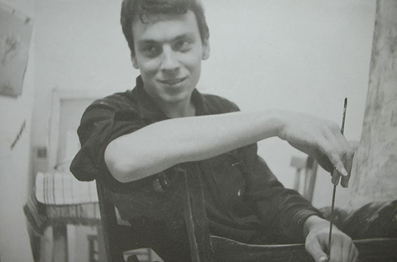
Dragoš Kalajić
On one February morning in 1992, graffiti (‘Death to the Jews’) appeared in Belgrade’s Jewish cemetery. The incident was hushed up. Articles written by D. Kalajić, who already had the reputation of being a Fascist and antisemite, are regularly published by the yellow press. However, the official organ of the Serbian Orthodox Church, Pravoslavlje, which is certainly not a magazine of that type, published an article in its February 1992 issue under the title ‘Jews Are Crucifying Christ Again’. The editor-in-chief, after the discreet intervention of the Jewish community, was publicly dismissed.
Several days later, the Tanjug news agency released a text written by its Moscow correspondent, Šaranović, saying that ‘the Jewish lobby in the Russian Foreign Ministry has helped Croatia and Slovenia get their diplomatic recognition from Russia’. Tanjug did not retract this report. Recently, the Serbian nationalist press and state-controlled television have been sympathetic towards the ‘patriotic coalition’ in Russia because of its opposition to UN sanctions imposed against Serbia and Montenegro. The antisemitism of the groups is being hushed up. There was also no reaction to the public rehabilitation of the leader of Serbian Fascism, Ljotić, the Chetnik leader, Draža Mihailović (who killed Jews as Communists) and of the Serbian quisling, General Nedić, who ordered and organized the deportation of Serbian Jewry to German-run camps in 1941-42.
The founding of the Serbian-Jewish Friendship Society in 1987 was an example of the political manipulation of Jews. This society was established by a group of Serbian nationalist intellectuals and it has become part of the propaganda machine in the internal wars in Yugoslavia—the consequences of which Jews in Serbia have yet to experience. It is important to note that the society, which has very few Jewish members, believed that reference to classic antisemitic slogans (such as ‘Jews control the press’, ‘Jews control the world’s business’, ‘the Jewish lobby rules America’) or to stereotypes (such as ‘Jews look after each other’)—as examples of positive behaviour—was a contribution to the promotion of friendship with the Jewish people.[25]
Antisemitism is the litmus test of nationalist chauvinism. Independently of the political will of the protagonists, antisemitism appears even when it is not wanted, as is the case in Croatia. In the former Yugoslavia, antisemitism was not of major importance, unlike in Poland, the former Soviet Union, Hungary, Romania and Slovakia. Since the former Yugoslavia is plagued by the highest degree of irrational nationalism and chauvinist hatred, there is a latent danger of antisemitism. Southern Slavs have each other to hate, they do not need Jews as an object for their hatred. However, all chauvinists and Fascists have an additional need for hatred; and, as we know, throughout history, this need has been satisfied by Jews.
Laslo Sekelj (1949-2001), sociologist, published the following books: On anarchism, 1982; Communism and the State, 1989; Revolution is not a party affair: communist critiques of bolshevism, 1987; Yugoslavia: the process of disintegreation, 1990; The time of dishoner: essays on the rule of nationalism, 1995.
[1] Marko Perić, ‘Demografska istraživanje’, Jevrejski pregled, nos. 11-12, 1972; nos. 1-2, 1973; nos. 3-4,1973; Demographic Survey of the Jewish Communities in Yugoslavia 1986, unpublished manuscript (Belgrade 1986).
[2] Jewish Historical Museum, Belgrade, founds 54, 58, 103,110,126, HO; Jevrejski bilten, vol. 4, nos. 1-2, 1953 and no. 5,1953; vol. 6, nos. 1-2, 1955; vol. 7, nos. 9-10, 1956; vol. 9, no. 3, 1958; Jevrejskipregled, vol. 11, nos. 10-11, 1960.
[3] Jevrejski bitten, vol. 5, no. 5, 1954.
[4] Jewish Historical Museum, Belgrade, founds 103,110; Albert Vajs, Jevrejski bilten, vol. 2, nos. 9-10,1951; vol. 5, no. 5,1954.
[5] ‘A Muslim “anti-Zionist” in Yugoslavia’, Patterns of Prejudice (London), vol. 6, no. 2, 1972, 20-21
[6] Husein Đozo (1912-1982), Islamic theologian and member of the SS Division Handschar. After a five year prison term, after WW2, he continued theological work and became a figure in the official organization of Yugoslav Muslims. Friend of a pro-Nazi Mufti of Jerusalem Al-Husseini, with whom he cooperated also after the war. In 1970. He started the magazine Preporod. Used by the state in the period of the development of the non-aligned movement, because of his knowledge of Arabic language and connections in the Middle East. (Antipolitika)
[7] Lutvo Kurić, ‘Jevrejska pravda’, Preporod, 15 February 1972.
[8] ‘Udruženje arapskih studenata’, Index, no. 218,24 March 1971.
[9] S. Milin ‘Uzgojio ih je cionizam’, Izbor, no. 11,1970,27-32.
[10] This primarily applies to the period immediately following the Middle East wars and to the leading newspapers and television stations in all the six republics of former Yugoslavia. The authors of these texts were journalists who specialized in foreign relations and, in one case, even a diplomat (Faik Dizdarević in Sarajevo’s Odjek of 1 January 1969). Fifteen or twenty years later, and this is part of the very nature of the Communist regime, some of these authors (like, recently, the editor-in-chief of Belgrade’s Polittka, Aleksandar Prlja) appeared in the very same newspapers as authors of pro-Israeli texts.
[11] On 26 February 1969, the official gazette of the Socialist Alliance of the Working People of Yugoslavia, Borba, reacted to the declaration of the Jihad made in the name of Yugoslav Muslims. Preporod’s editorial board issued a ‘correction’ and an apology for Kurić’s antisemitic article (1 March 1971). In its following issue, Index published three stinging reviews of the article, ‘Association of Arab Students’. Faik Dizdarević’s text triggered a number of reactions in the magazine Odjek. The weekly NIN (V. Miletic’s article, ‘Five Stories about Hate’) and Student (‘Antisemitism in the Yugoslav Press’) in 1971 reacted to the above-mentioned texts as well as to the promotion of The Protocols. A. Novak criticized Soviet antisemitism in Ljubljana’s daily Delo (‘Message to Soviet Jews’, 12 December 1970).
[12] Two months later, unknown persons removed the tablet at the entrance to the Split Jewish Town Hall (18 September 1982), and unknown persons daubed a slogan at the entrance to the Zagreb Jewish Town Hail, ‘Down with the Jews’ (22 October 1982); see Jevrejski pregled, vol. 34, nos. 1-2,1982.
[13] Danilo Kiš, ‘Otvoreno pismo glavnom i odgovornom uredniku’, Ovdje, no. 23, April 1971.
[14] Dragoš Kalajić (1943-2005), painter, ideologue of the intellectual neofascist circle New Serbian Right. Already during the end of the sixties he started publishing texts written under the influence of Julius Evole, who he knew personally. (Antipolitika)
[15] Dragos Kalajic, ‘Individua i licnost’, Delo, no. 6,1971, 677.
[16] Miro Glavurtić (1932- ), member of the Belgrade art group Mediala, founded in 1953, whose members were close to reactionary and mystical trends. (Antipolitika)
[17] Nikola Antić, Po kome je zakonu Hristos osuden na smrt’, and ‘Kaine, gde ti je brat Avelj?’, Pravoslavni misionar, no. 2,1971 and no. 6,1971; see also articles in no. 2,1976, no. 2,1979 and no. 1, 1980.
[18] For example, Vjesnik, 19 January 1971 (article announcing the film, The Pawnbroker, appearing on television; Politika, 28 October 1973 (B. Dikić, ‘Stammering Moses’), Sarajevo’s Svijet, November 1984 (Zlatko Dizdarevic, ‘Operation Moses’); and in various letters to the editor published by Telex (Maribor) and the Slovenian Catholic review, 2,000, published in the 1980s.
[19] Jevrejski pregled, vol. 40, nos. 1-4,1989 and nos. 9-12,1989.
[20] Franjo Tudjman, Respuca povijesne zbiljnosti (Zagreb 1989), 160, 316-20
[21] ‘Antisemitism in Central and Eastern Europe: Yugoslavia’, IJA Research Report, nos. 4-6, 1991; Slobodni tjednik, no. 3, 14 March 1990.
[22] Borba, no. 1,2 February 1992.
[23] Jevrejski pregled, vol. 40, nos. 5-8,1989.
[24] Reč srpskom narodu—Kroz tamnički prozor (Himelstir 1985 and Valjevo 1991).
[25] An election held in the Jewish community of Belgrade in May 1992 resulted in a complete collapse of the list supported by the Serbian-Jewish Society; nobody from that list was elected.
